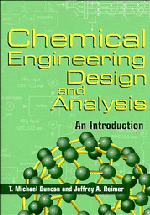Book contents
- Frontmatter
- Contents
- Preface
- Acknowledgments
- 1 An Overview of Chemical Engineering
- 2 Process Design
- 3 Models Derived from Laws and Mathematical Analysis
- 4 Graphical Analysis
- 5 Dimensional Analysis and Dynamic Scaling
- 6 Transient Processes
- Appendix A List of Symbols
- Appendix B Units, Conversion Factors, and Physical Constants
- Appendix C Significant Figures
- Appendix D Graph Paper
- Appendix E Mathematics, Mechanics, and Thermodynamics
- Appendix F Glossary of Chemical Engineering
- Index
3 - Models Derived from Laws and Mathematical Analysis
- Frontmatter
- Contents
- Preface
- Acknowledgments
- 1 An Overview of Chemical Engineering
- 2 Process Design
- 3 Models Derived from Laws and Mathematical Analysis
- 4 Graphical Analysis
- 5 Dimensional Analysis and Dynamic Scaling
- 6 Transient Processes
- Appendix A List of Symbols
- Appendix B Units, Conversion Factors, and Physical Constants
- Appendix C Significant Figures
- Appendix D Graph Paper
- Appendix E Mathematics, Mechanics, and Thermodynamics
- Appendix F Glossary of Chemical Engineering
- Index
Summary
HAVE YOU EVER MARVELED at the beauty of an exquisite design? How did the engineers devise such a complex device or system? Surely they must have been geniuses. Although this may be true in some cases, good engineering generally does not require genius (although it certainly helps). Complex designs usually evolve from simple designs. It is important to be able to analyze and evaluate the effects of each evolutionary step in a design.
How does a good design begin? Linus Pauling, who earned his B.S. degree in chemical engineering (Oregon State, 1922), and received a Nobel Prize in Chemistry (1954) and a Nobel Peace Prize (1962), recommended “The best way to get a good idea is to get a lot of ideas.” We modify and extend this useful advice to “The best way to get a good design is to create many designs and choose the best.” To choose the best design, one must be able to analyze and evaluate the designs.
How does one analyze and evaluate a design? One option is to build the system and test it. This is appropriate when the design is for a small item, such as a can opener. This approach is also appropriate for a medium-sized item, such as an automobile, if one expects to manufacture thousands of units. But clearly it is impractical to build a full-sized system when the system is very large and only a few, perhaps only one, will be built.
- Type
- Chapter
- Information
- Chemical Engineering Design and AnalysisAn Introduction, pp. 61 - 138Publisher: Cambridge University PressPrint publication year: 1998

